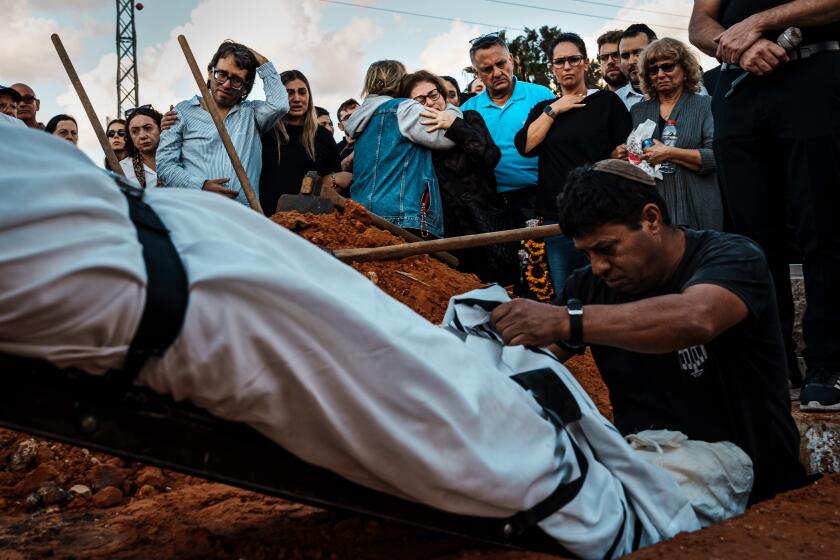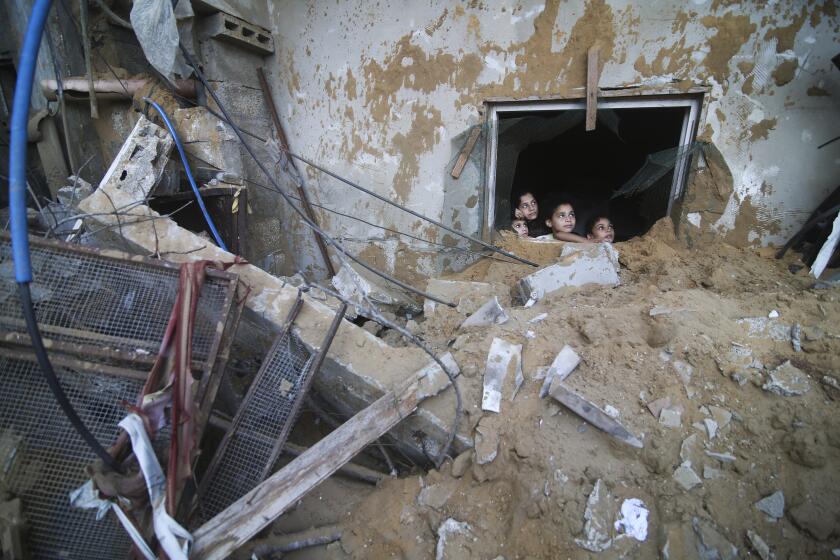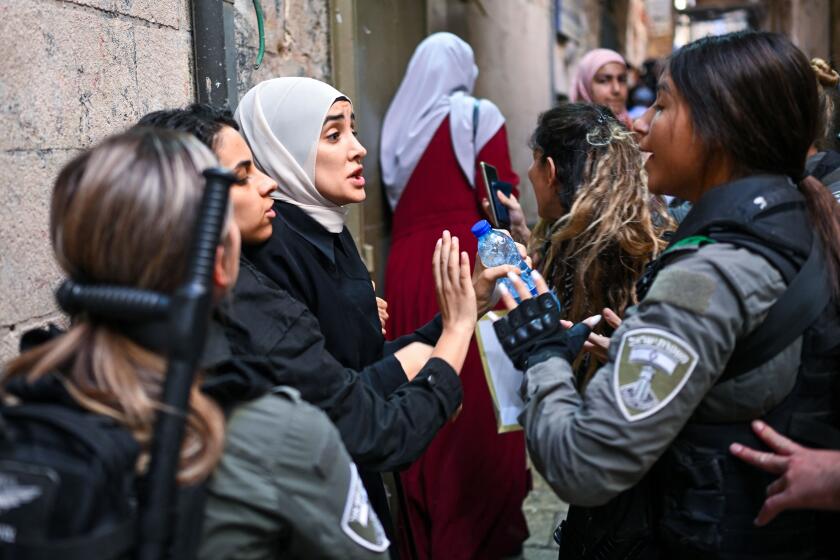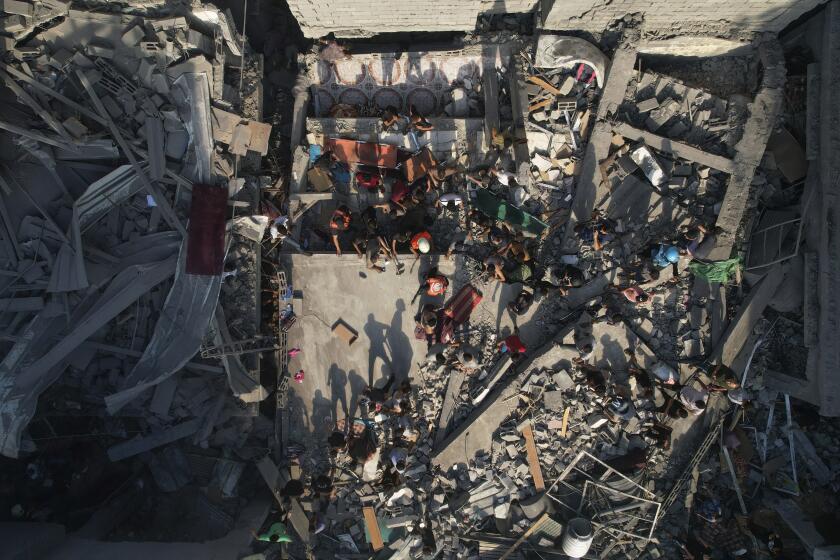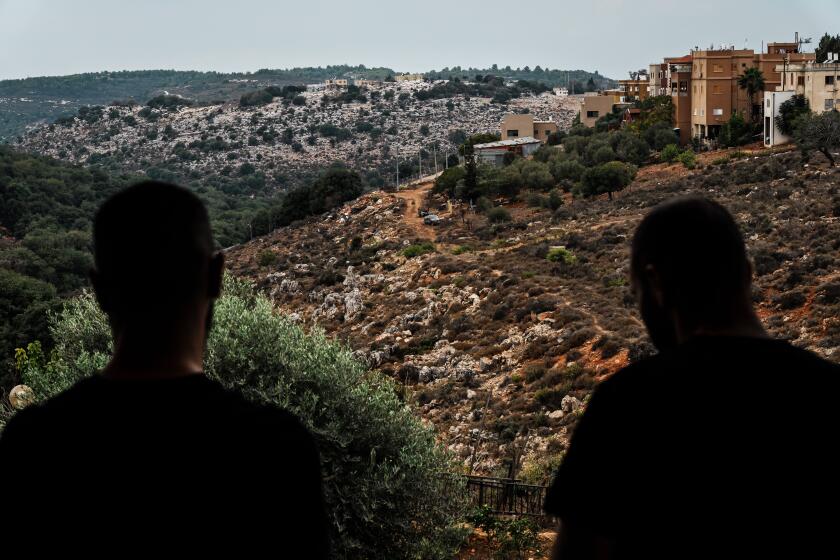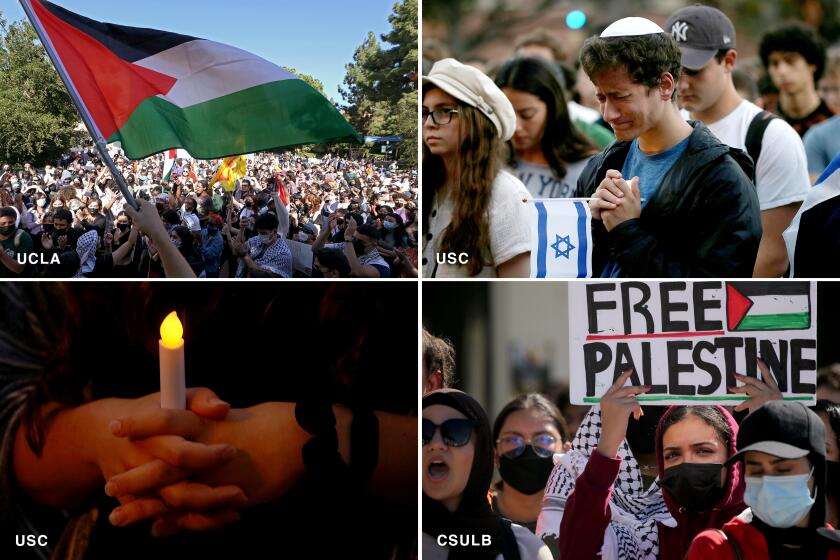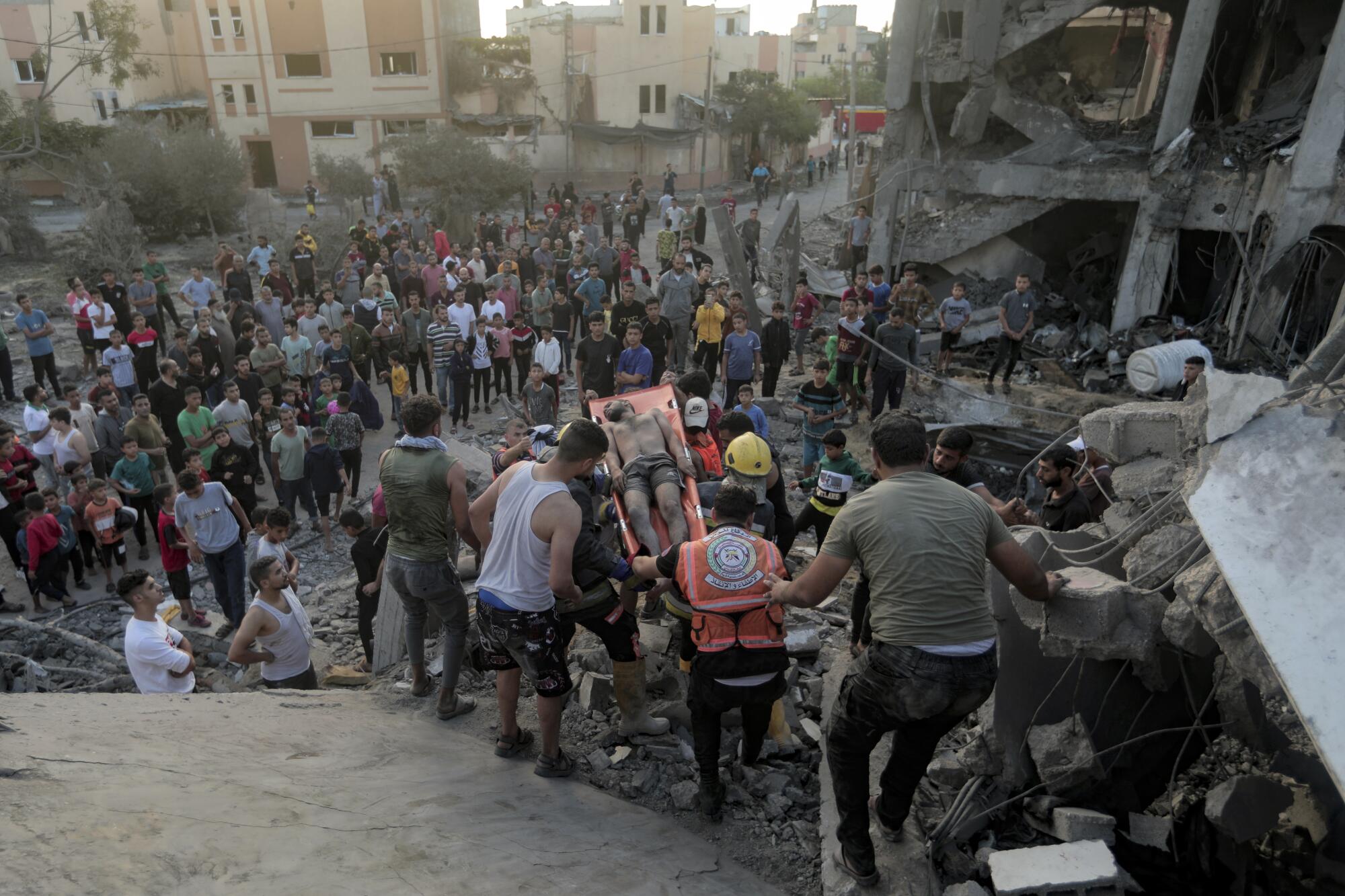
- Share via
KHAN YUNIS, Gaza Strip — A massive blast rocked a Gaza City hospital packed with wounded and other Palestinians seeking shelter Tuesday, killing hundreds of people, the Hamas-run Health Ministry said. Hamas blamed an Israeli airstrike, while the Israeli military said the hospital was hit by a rocket misfired by Palestinian militants.
The Gaza Health Ministry said at least 500 people were killed. Video that the Associated Press confirmed was from the hospital showed fire engulfing the building and the hospital’s grounds strewn with torn bodies, many of them young children. Around them in the grass were blankets, school backpacks and other belongings.
Israel-Hamas war: In Israel, a quest to identify unrecognizable bodies. In Gaza, bodies are piled and some stored in ice cream trucks as power fails.
As rage spread across the region, and with President Biden heading to the Mideast in hopes of stopping the war from spreading, Jordan’s foreign minister said his country canceled a regional summit scheduled for Wednesday in Amman. Biden had planned to meet there with Jordan’s King Abdullah II, Palestinian President Mahmoud Abbas and Egyptian President Abdel Fattah Sisi.
The war between Israel and Hamas was “pushing the region to the brink,” Jordanian Foreign Minister Ayman Safadi told state-run television. He said Jordan would host the summit only when everyone had agreed its purpose would be to “stop the war, respect the humanity of the Palestinians and deliver the aid they deserve.”
Biden will now visit only Israel, a White House official said.
The bloodshed in Gaza unfolded as the U.S. tried to convince Israel to allow the delivery of supplies to desperate civilians, aid groups and hospitals in the tiny Gaza Strip, which has been under a complete siege since Hamas’ deadly rampage in southern Israel this month.
Hamas called Tuesday’s hospital blast “a horrific massacre,” saying it was caused by an Israeli strike.
The Israeli military blamed Islamic Jihad, a smaller, more radical Palestinian militant group that often cooperates with Hamas in their shared struggle against Israel. The military said that Islamic Jihad militants had fired a barrage of rockets near the hospital at the time and that “intelligence from multiple sources” indicated the group was responsible.
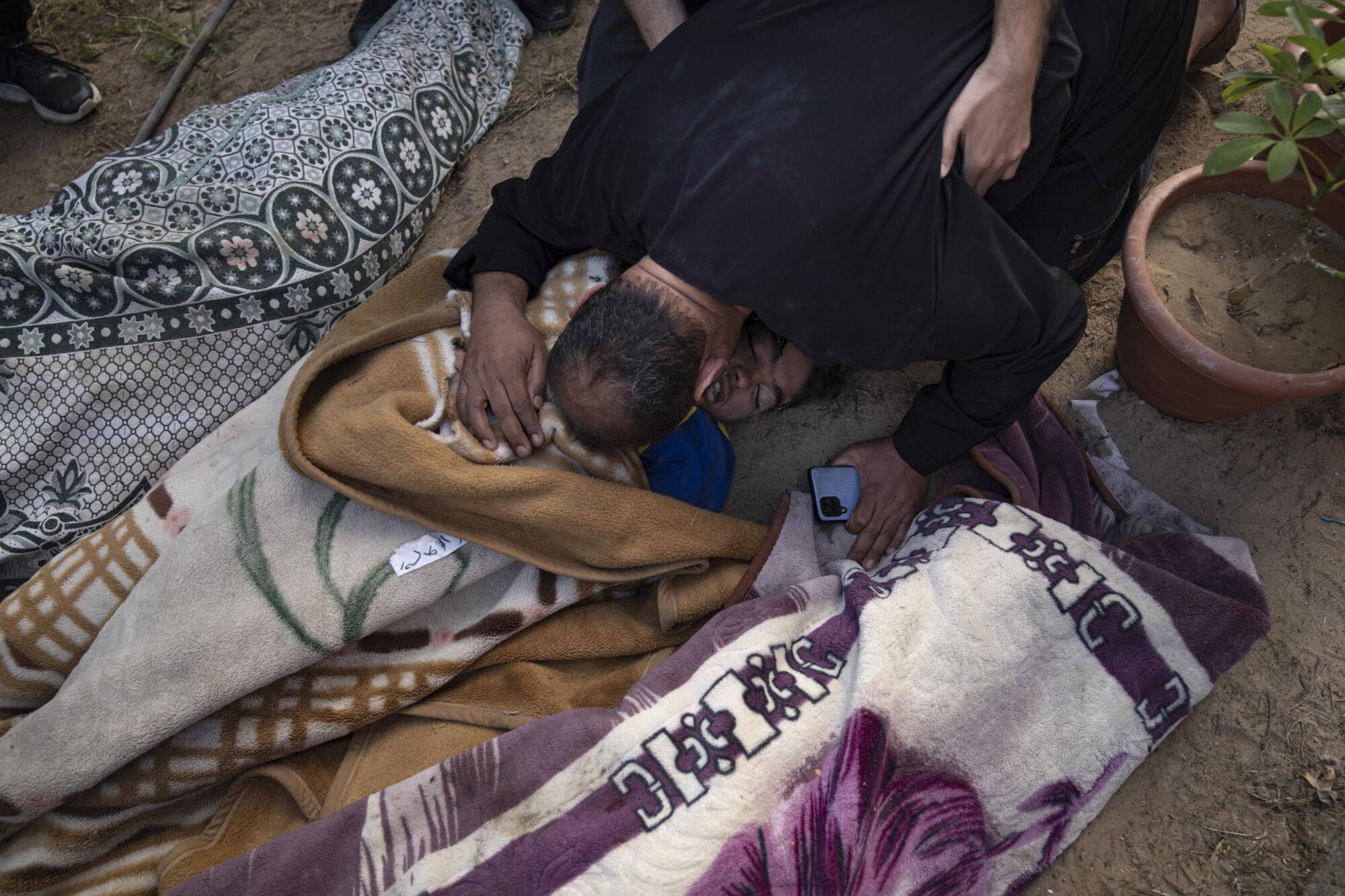
In a briefing with reporters, Israel’s chief army spokesman, Rear Adm. Daniel Hagari, said the army determined there were no air force, ground or naval attacks in the area at the time of the blast. He said radar detected outgoing rocket fire at the same moment, and intercepted communications between militant groups indicating that Islamic Jihad fired the rockets.
Hagari also shared aerial footage collected by a military drone that showed a blast that he said was inconsistent with Israeli weaponry. He said the explosion occurred in the building’s parking lot.
Since the war began, the military said in a statement that roughly 450 rockets fired at Israel by militant groups had landed in Gaza, “endangering and harming the lives of Gazan residents.”
Islamic Jihad dismissed those claims, accusing Israel of “trying hard to evade responsibility for the brutal massacre it committed.”
The group pointed to Israel’s order that the hospital be evacuated and its previous bombing of the hospital complex as proof that it was an Israeli target. It also said the scale of the explosion, the angle of the bomb’s fall and the extent of the destruction all pointed to Israel.
Hundreds of Palestinians had taken refuge in Ahli Arab Hospital and other medical centers in Gaza City in past days, hoping they would be spared bombardment after Israel ordered all residents of the city and surrounding areas to evacuate to the southern Gaza Strip.
Ambulances and private cars rushed some 350 casualties from the Ahli Arab Hospital to Gaza City’s main hospital, Shifa, which was already overwhelmed with wounded from other strikes, said its director, Mohammed Abu Selmia. Screaming in pain, the wounded were laid onto bloody floors.
“We are squeezing five beds into a single tiny room. We need equipment, we need medicine, we need beds, we need anesthesia, we need everything,” Abu Selmia said. He warned , that fuel for the hospital’s generators would run out within hours.
Hundreds of Palestinian Americans are reportedly stranded in Gaza, frantically searching for ways to flee before Israel’s expected ground assault.
Before the Ahli Arab Hospital deaths, Israeli strikes on Gaza killed at least 2,778 people and wounded 9,700, according to the Gaza Health Ministry. Nearly two-thirds of those killed were children, a ministry official said. An additional 1,200 people across Gaza are believed to be buried under the rubble, alive or dead, health authorities said.
Hamas’ Oct. 7 attack in southern Israel killed more than 1,400 people, mostly civilians, and the militants took about 200 captives into Gaza. Hamas militants in Gaza have launched rockets every day since, aiming at cities across Israel.
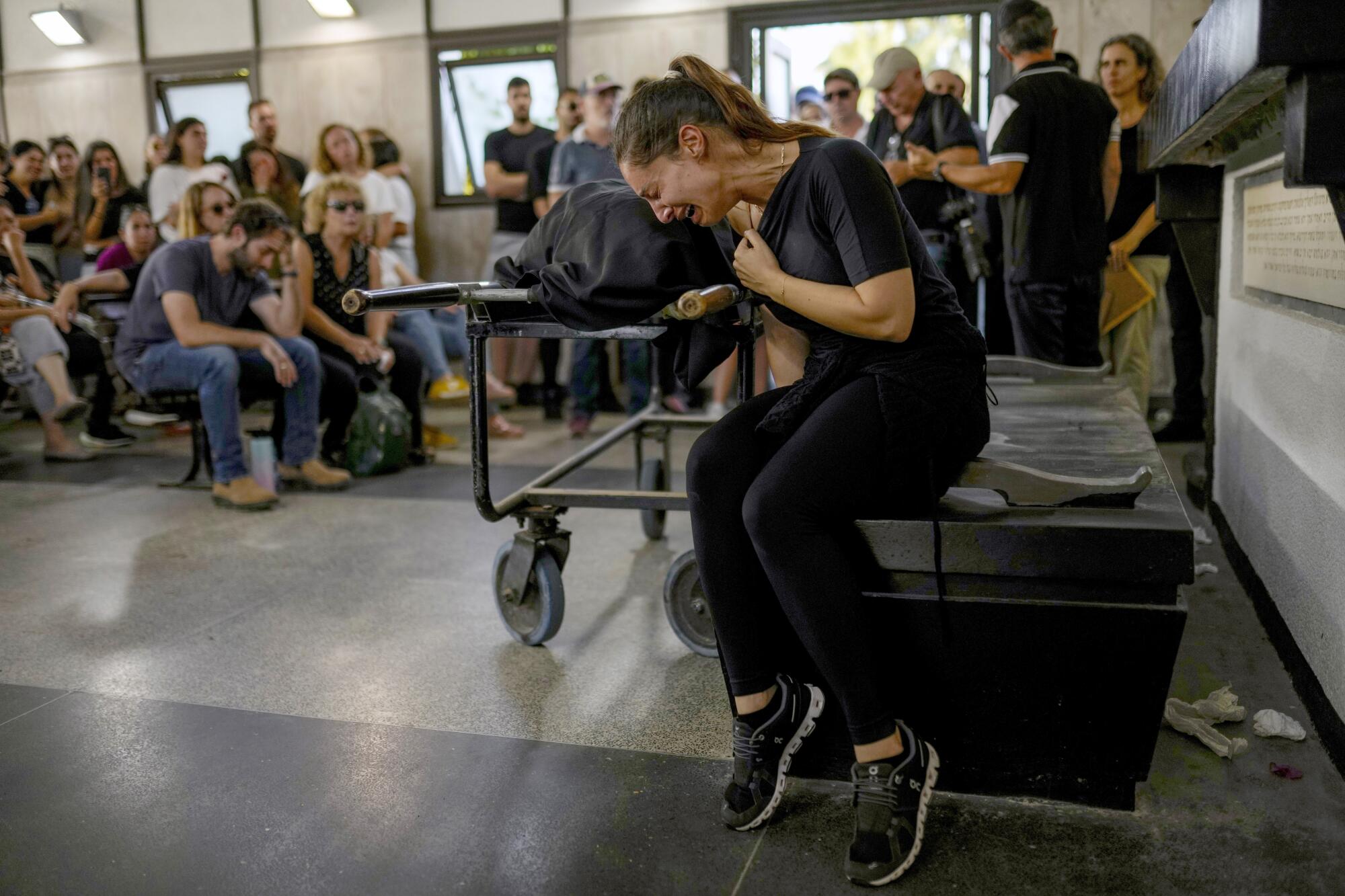
Hundreds of Palestinians flooded the streets of major West Bank cities including Ramallah, the seat of the Palestinian Authority, where protesters hurled stones at Palestinian security forces who fired back with stun grenades. Others threw stones at Israeli checkpoints, where soldiers killed one Palestinian, West Bank authorities said. Hundreds of people joined protests that erupted in Beirut and Amman, where an angry crowd gathered outside the Israeli Embassy.
As the Jewish Sabbath fell and Muslims marked their principal prayer day, Israelis and Palestinians struggled with the terrifying new reality after the militant group Hamas’ deadly attack on Israel.
Biden’s visit in part aims to prevent the war from sparking a broader regional conflict. Violence flared Tuesday along Israel’s border with Lebanon, where Iranian-backed Hezbollah militants operate and where Israel has evacuated nearby towns.
With tens of thousands of troops massed along the border, Israel has been expected to launch a ground invasion into Gaza, but its plans remained uncertain.
“We are preparing for the next stages of war,” military spokesman Lt. Col. Richard Hecht said. “We haven’t said what they will be. Everybody’s talking about a ground offensive. It might be something different.”
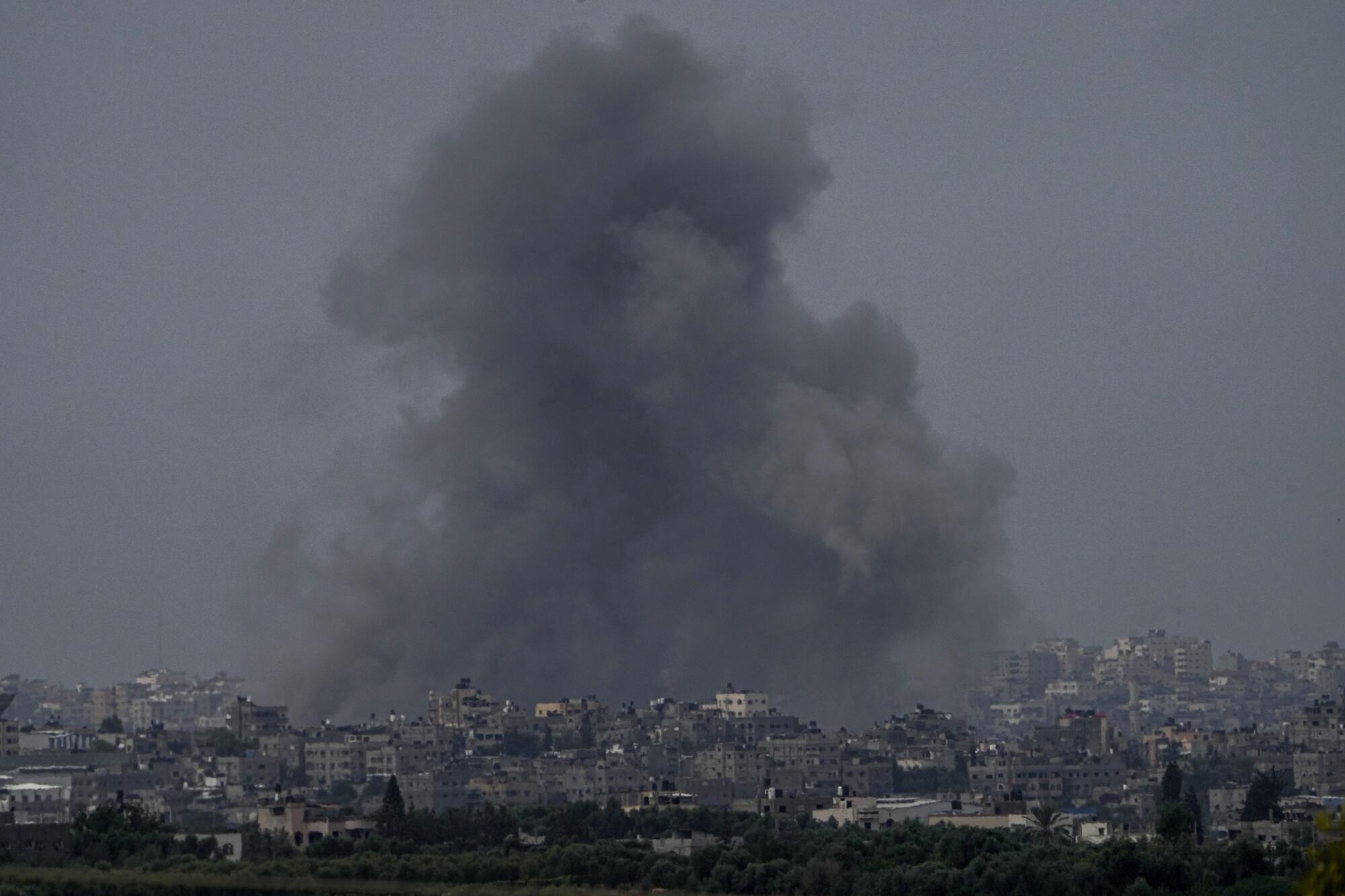
Throughout the day Tuesday, airstrikes killed dozens of civilians and at least one senior Hamas figure in the southern Gaza Strip, to which the Israeli military had told Palestinians to flee. An Associated Press reporter saw around 50 bodies brought to Nasser Hospital after strikes in the southern city of Khan Yunis.
An airstrike in Deir al Balah reduced a house to rubble, killing a man and 11 women and children inside and in a neighboring house. Some of the victims had evacuated from Gaza City. Witnesses said there was no warning before the strike.
Shelling from Israeli tanks hit a U.N. school in central Gaza where 4,000 Palestinians had taken refuge, killing six people and wounding dozens, the United Nations Palestinian refugee agency said. At least 24 U.N. installations have been hit in the last week, killing at least 14 members of the agency’s staff.
Palestinian Americans with Gaza connections struggle with feelings of helplessness over violence after Hamas’ attack and Israel’s retaliation.
The Israeli military said it was targeting Hamas hideouts, infrastructure and command centers.
A barrage of strikes crashed into the Bureij refugee camp in central Gaza, leveling an entire block of homes and causing dozens of casualties among families inside, residents said. Among those killed was a top Hamas commander, Ayman Nofal, the group’s military wing said — the highest-profile militant known to have been killed so far in the war.
Nofal, formerly the intelligence chief of the groiup’s armed wing, was in charge of Hamas militant activities in the central Gaza Strip, including coordinating activities with other militant groups.

In Gaza City, Israeli airstrikes also hit the house of Hamas’ top political official, Ismail Haniyeh, killing at least 14 people. Haniyeh is based in Doha, Qatar, but his family lives in Gaza City. The Hamas media office did not immediately identify those killed.
Israeli Prime Minister Benjamin Netanyahu sought to put the blame on Hamas for Israel’s retaliatory attacks and the rising civilian casualties in Gaza. “Not only is it targeting and murdering civilians with unprecedented savagery, it’s hiding behind civilians,” he said.
With Israel barring entry of water, fuel and food into Gaza since Hamas’ brutal attack Oct. 7, U.S. Secretary of State Antony J. Blinken secured an agreement with Netanyahu to discuss creation of a mechanism for delivering aid to the territory’s 2.3 million people. U.S. officials said the move might appear modest, but stressed that it was a significant step forward.
On Israel’s border with Lebanon, residents are worried that groups like Hezbollah will join a war that eventually spirals into a regionwide conflict.
Still, as of late Tuesday, there was no deal in place. A top Israeli official said his country was demanding guarantees that Hamas militants would not seize any aid deliveries. Tzachi Hanegbi, head of Israel’s National Security Council, suggested entry of aid also depended on the return of hostages held by Hamas.
More than 1 million Palestinians have fled their homes — roughly half of Gaza’s population — and 60% are now south of the evacuation zone, the U.N. said.
College campuses are supposed to be bastions of intellectual discourse and debate, but the war in Gaza underscores tense narratives and little if any interchange between students.
Aid workers warned that the territory was near complete collapse. Hospitals were on the verge of losing electricity, threatening the lives of thousands of patients, and hundreds of thousands of people searched for bread and water.
News Alerts
Get breaking news, investigations, analysis and more signature journalism from the Los Angeles Times in your inbox.
You may occasionally receive promotional content from the Los Angeles Times.
At the Rafah crossing, Gaza’s only connection to Egypt, truckloads of aid were waiting to enter. The World Food Program said that it had more than 300 tons of food waiting to cross into Gaza.
Jobain, Kullab, Nessman and Lee reported from Khan Yunis, Baghdad, Jerusalem and Amman, respectively. Associated Press journalists Amy Teibel in Jerusalem; Abby Sewell in Beirut; Samy Magdy and Jack Jeffrey in Cairo; and Ashraf Sweilam in Arish, Egypt, contributed to this report.
More to Read
Sign up for Essential California
The most important California stories and recommendations in your inbox every morning.
You may occasionally receive promotional content from the Los Angeles Times.
